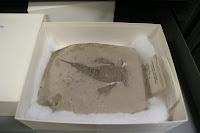The Science Behind the Museum
A different kind of museum visit, indeed.
The New York State Museum in Albany NY, hosted a one-day Science teachers' workshop on “Darwin’s Origin in the 21st Century on October 24, 2015.
The workshop participants were able to open drawers and cabinets of thousands of paleontologic and taxonomic artifacts and specimina that are identified, named and accessed by the New York State Museum. The Empire State can boast of its natural treasures of prehistoric times unearthed from beneath its crust, from trilobites to mastodons, birds to insects, brophytes to vascular plants, whales to mammals, tree stumps to petrified trees, and thousands of compression and impression fossils. It is truly an amazing experience to see how meticulously do the curators and research students prepare animal specimen by removing the bones from the skin, exposing the fleshy bones to bug infestation, articulating the bones for reconstruction, preserving the tissues and running polymerase chain reactions for genetics and phylogeny studies.
As one enters the paleobotany collection, one can not help but be awed by the enormous artifact collection from the Gilboa fossil forest that includes numerous fossil stumps, trunk sections, and a crown of Eospermatopteris. It also includes Devonian materials from across New York state, and specimens from Pennsylvania and other areas of the U.S. The Museum consists of 600,000 fossil specimens from the Paleozoic era, Cambrian-Ordovician conodonts and graptolites and earliest Cambrian small shell faunas.
 |
| Tree stumps preserved from the Gilboa forest, Schoharie County, NY. |
Stored and maintained among hundreds of cabinets are a collection of over 20,000 ornithology specimens that include skeletons, skins, taxidermy mounts, frozen tissues, and egg sets collected throughout New York since the 1840's. The vertebrate paleontology collection consists of nearly 12,000 specimens from across the State and includes fossils predominately from the late Pleistocene epoch. Carefully preserved in well-maintained environments are over 15,000 mammalian specimens in the form of skins, bones, fluid specimens, and frozen tissues of important New York mammals, from mice to moose, from bat to baleen whale. Before leaving the preservation chambers, one can not miss the Cohoes mastodon remains that are utterly imposing by themselves.
 |
| New York State's official fossil, Eurypterus remipes, crawled along the bottom of the shallow, brackish sea that covered much of New York during the Silurian Age, which is over 400 million years ago. |
Although we were not able to visit the geology and ichthyology collections, we realized that the Museum has an equally rich array of New York State minerals, rocks, meteorites and gems, and a vast collection of approximately 62,000 lots of freshwater and marine fish collected from 1843 to the present in all parts of the state.